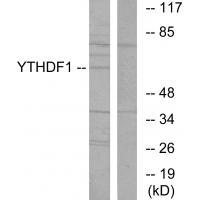
| WB | 1/500-1/3000 | Human,Mouse,Rat |
| IF | 咨询技术 | Human,Mouse,Rat |
| IHC | 咨询技术 | Human,Mouse,Rat |
| ICC | 技术咨询 | Human,Mouse,Rat |
| FCM | 咨询技术 | Human,Mouse,Rat |
| Elisa | 咨询技术 | Human,Mouse,Rat |
| Aliases | YTH domain family protein 1; Dermatomyositis associated with cancer putative autoantigen 1; DACA-1; YTHDF1; C20orf21 |
| Entrez GeneID | 54915; |
| WB Predicted band size | 61kDa |
| Host/Isotype | Rabbit IgG |
| Antibody Type | Primary antibody |
| Storage | Store at 4°C short term. Aliquot and store at -20°C long term. Avoid freeze/thaw cycles. |
| Species Reactivity | Human,Mouse,Rat |
| Immunogen | Synthesized peptide derived from N-terminal of human YTHDF1. |
| Formulation | Purified antibody in PBS with 0.05% sodium azide. |
+ +
以下是关于YTHDF1抗体的3篇代表性文献,包含文献名称、作者及摘要概括:
---
1. **文献名称**:*N6-methyladenosine modulates messenger RNA translation efficiency*
**作者**:Wang X, et al.
**摘要**:该研究揭示了YTHDF1通过识别mRNA上的m6A修饰促进翻译效率的机制,实验中利用YTHDF1抗体进行免疫沉淀和蛋白质定位分析,证明其在细胞质中与核糖体相互作用并调控靶基因表达。
---
2. **文献名称**:*YTHDF1 links hypoxia adaptation and non-small cell lung cancer progression*
**作者**:Shi Y, et al.
**摘要**:研究通过YTHDF1抗体进行Western blot和免疫组化实验,发现YTHDF1在低氧条件下通过增强致癌蛋白翻译促进肺癌发展,提示其作为癌症治疗靶点的潜力。
---
3. **文献名称**:*m6A-binding protein YTHDF1 suppresses gastric cancer progression by regulating immune microenvironment*
**作者**:Han D, et al.
**摘要**:利用YTHDF1抗体检测胃癌组织中蛋白表达水平,发现YTHDF1通过调控免疫相关基因的m6A修饰抑制肿瘤生长,并影响肿瘤微环境中T细胞的功能。
---
如需具体实验细节(如抗体货号),建议通过PubMed或抗体供应商数据库(如CiteAb)进一步检索。
The YTHDF1 antibody is a crucial tool in studying the functional role of YTHDF1. a member of the YTH domain-containing family of proteins that recognize N6-methyladenosine (m6A), the most prevalent internal RNA modification in eukaryotes. YTHDF1 is characterized as an m6A "reader" protein, primarily localizing in the cytoplasm where it facilitates the translation of m6A-modified mRNAs by interacting with ribosomes and translation initiation factors. Its involvement in regulating gene expression has linked it to various physiological and pathological processes, including cancer progression, neurodevelopment, and immune responses.
Antibodies targeting YTHDF1 are widely used in techniques such as Western blotting, immunoprecipitation (IP), and immunofluorescence (IF) to detect protein expression, subcellular localization, and molecular interactions. These antibodies are essential for elucidating YTHDF1's mechanism in m6A-dependent RNA metabolism, such as promoting oncogenic translation in tumors or modulating synaptic plasticity in neurological disorders. Commercial YTHDF1 antibodies are typically developed in rabbit or mouse hosts, with both monoclonal and polyclonal variants available. Validation often includes testing in knockout (KO) cell lines or tissues to confirm specificity. Researchers rely on these antibodies to explore YTHDF1's therapeutic potential, including its role as a biomarker or target in diseases like glioblastoma, colorectal cancer, and Alzheimer's disease.
×